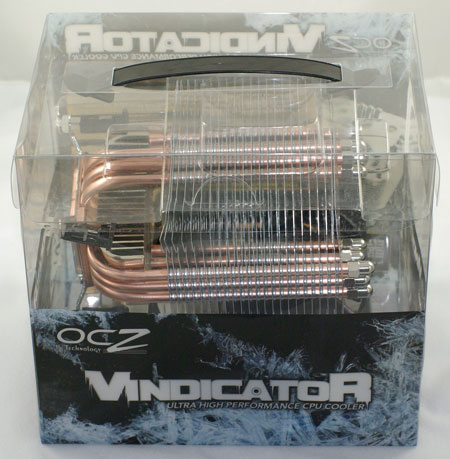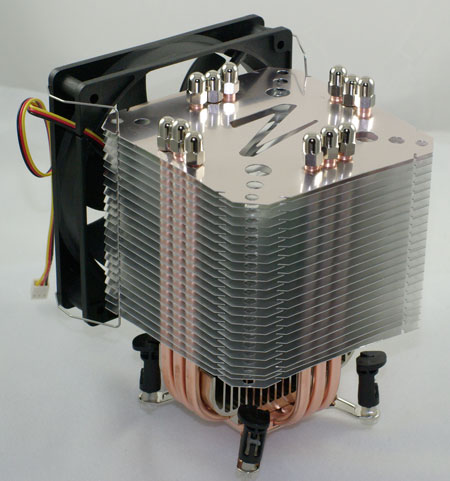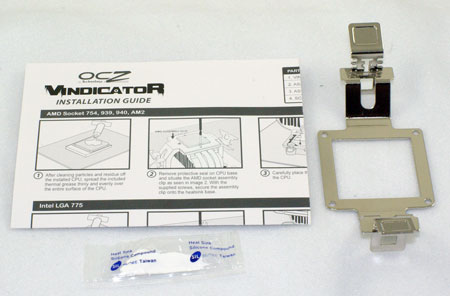OCZ Vindicator: Heatpipe Tower Cooling from OCZ
by Wesley Fink on April 5, 2007 4:00 AM EST- Posted in
- Cases/Cooling/PSUs
OCZ Vindicator
The Vindicator is packaged is a slick acrylic box. This certainly allows the package to stand out on shelves, since you can see everything about the cooler through the clear shell.

While the packaging makes the Vindicator stand out, we do have some questions about how well it protects the heatpipe tower from damage during shipment. The cooler we received looked great in the package and the package seemed sturdy enough, but the shipping process had caused a lot of crushed fins opposite the visible side of the package. They were straightened with a knife and some patience, but not all buyers will want to straighten fins on a new cooler. A sturdier package would help.

The Vindicator cooler is a bit different in configuration from most other heatpipe coolers. While it uses 6 u-shaped heatpipes to cool they are arranged as 3-pipe arrays at a ninety degree angle. This places three heatpipe rods on each side. Unlike the Scythe Infinity or Thermalright Ultra 120, which are wider than they are flat, the Vindicator design makes a square cooler which is much deeper than most of the other heatpipe coolers. This is the same configuration used in the Scythe Ninja Rev. B.

As already mentioned the Socket 775 adapter is installed, but the AM2/939/940/754 adapter is also included along with a small packet of thermal compound and installation instructions. You are not required to remove the motherboard to mount the Vindicator. It uses standard Intel-type push pins for mounting on Socket 775. However, space is very limited above the mounting area so you will likely want to mount the Vindicator before installing a fan.
The Vindicator is a big cooler and it takes up a lot of space in the case. While a simple installation is always preferred, the weight that is being supported by those four pop-in clips is a real concern. With no back plate this is not a cooler you will want to use in a system you move around. The motherboard could easily be overstressed and fail or it could actually break the board with rough handling.
Specifications
The Vindicator will mount on all current CPU sockets, but it does not support the older Intel Socket 478. If you have a Socket 478 CPU you will need to buy the Scythe Ninja Rev. B instead.
The fan included with the Vindicator is clearly aimed at the silent cooler market. The airflow is relatively low and noise is rated at just 18.5 DBA. However, the fan mount will handle any 120mm fan, so you can choose from a wide variety of popular 120mm fans if the stock fan does not deliver what you are looking for.
The Vindicator also allows mounting of multiple fans if you choose, as we demonstrated in the Scythe Infinity review. The aluminum cooling fins have a pair of grooves on each side to provide flexibility in fan mounting. Using extra wires and careful positioning you should be able to mount as many as 4 fans for cooling on the Vindicator.
The Vindicator is packaged is a slick acrylic box. This certainly allows the package to stand out on shelves, since you can see everything about the cooler through the clear shell.

While the packaging makes the Vindicator stand out, we do have some questions about how well it protects the heatpipe tower from damage during shipment. The cooler we received looked great in the package and the package seemed sturdy enough, but the shipping process had caused a lot of crushed fins opposite the visible side of the package. They were straightened with a knife and some patience, but not all buyers will want to straighten fins on a new cooler. A sturdier package would help.

The Vindicator cooler is a bit different in configuration from most other heatpipe coolers. While it uses 6 u-shaped heatpipes to cool they are arranged as 3-pipe arrays at a ninety degree angle. This places three heatpipe rods on each side. Unlike the Scythe Infinity or Thermalright Ultra 120, which are wider than they are flat, the Vindicator design makes a square cooler which is much deeper than most of the other heatpipe coolers. This is the same configuration used in the Scythe Ninja Rev. B.

As already mentioned the Socket 775 adapter is installed, but the AM2/939/940/754 adapter is also included along with a small packet of thermal compound and installation instructions. You are not required to remove the motherboard to mount the Vindicator. It uses standard Intel-type push pins for mounting on Socket 775. However, space is very limited above the mounting area so you will likely want to mount the Vindicator before installing a fan.
The Vindicator is a big cooler and it takes up a lot of space in the case. While a simple installation is always preferred, the weight that is being supported by those four pop-in clips is a real concern. With no back plate this is not a cooler you will want to use in a system you move around. The motherboard could easily be overstressed and fail or it could actually break the board with rough handling.
Specifications
The Vindicator will mount on all current CPU sockets, but it does not support the older Intel Socket 478. If you have a Socket 478 CPU you will need to buy the Scythe Ninja Rev. B instead.
| OCZ Vindicator Specifications | |
| Heatsink | |
| Dimensions | 110(L) X 110(W) X 150(H)mm (excluding fan) |
| Weight | 640g (excluding fan) |
| Material | Copper and Aluminum |
| Fan Configuration | Supports 120mm fans (120mm fan included) Open or closed mounting posts. |
| Included Fan | |
| Fan Size | 120mm x 120mm x 25mm |
| Bearing Type | Sleeve Bearing |
| Noise Level | 18.5 dB-A |
| Speed | 1000 RPM |
| Air Flow | 40 CFM |
| Static Pressure | 1.40mm H2O |
| Weight | 130g (fan only) |
The fan included with the Vindicator is clearly aimed at the silent cooler market. The airflow is relatively low and noise is rated at just 18.5 DBA. However, the fan mount will handle any 120mm fan, so you can choose from a wide variety of popular 120mm fans if the stock fan does not deliver what you are looking for.
The Vindicator also allows mounting of multiple fans if you choose, as we demonstrated in the Scythe Infinity review. The aluminum cooling fins have a pair of grooves on each side to provide flexibility in fan mounting. Using extra wires and careful positioning you should be able to mount as many as 4 fans for cooling on the Vindicator.










41 Comments
View All Comments
yyrkoon - Monday, April 9, 2007 - link
These 40 posts are a mostly 'bitches' from people who 'claim' Anandtech reviewers are 'wrong' ?In case it is not already obvious, Anandtech is an enthusiast site, which means they cater to the overclockers, and people who care about computer hardware in general, not people who can not sleep when someone drops a pin over in china . . .
Seriously, I can understand pointing out typos, and a disagreement or two on the finer points, and what not, but complaining because you think their data is incorrect, based on data given by another site(which obviously is not even in the same class of a site), is plain stupid. Do you actually know for a fact that the data from this other site is correct ? If so, how do you know ? If 30dba is what is considered a quite room, wtf does it matter if Andantech 'claims' the fan used here is 14dba or not ? Personally, I think some of you guys, are entirerly too anal, and need to learn how to socialize a tad better. something like: 'I do not think 14dba is possible on a computer fan(Correct me if I am wrong), but <insert some other point here>' probably would have worked just fine, without sounding like you are bashing the reviewers of the site.
There are many ways to say that you think the data given is incorrect, without sounding like a horses ass, and in the long run, no one is twisting your arm to come here and read the reviews. If you really, really like this other site so much, that you feel it nessisary to come here and bash the Anandtech crew, I think we all can agree, it would be a much better place here, if you just stayed away.
Affectionate-Bed-980 - Friday, April 6, 2007 - link
Real world testing is great, but isnt this how someone's Core 2 duo article got FLAMED to death because there was a bottleneck?When we test fans, yea it's great to know that 14 dB fan won't do jack in my system when my PSU is running around 30.
Just like it doesn't matter that my sticks of RAM can clock to DDR600 because my Opteron 170 won't let me go past 250 HTT anyways, so I can only go to DDR500 anyways unlesss I really want a lower multiplier.
There are limits left and right, but EVERYONE wants to know the specifications and capabilities of THE PRODUCT IN INTEREST. This is similar to high school science or junior high or whenever you learn that in experimenets, your goal is to isolate one variable and test it.
I don't give a damn that my PSU is going to be loud. What if i used a fanless system? There are people out there who want to know how loud this damn SilenX fan is, and we wnat to know how loud it REALLY IS compared to the specs.
I'm tired of hearing how really only REAL WORLD performance matters. Give us the LAB numbers and then give us how real world performance might come into play.
As an engineer, when you look up materials properties like strength tests, hardness numbers, stress concentration data, it's ALL lab samples that are perfect. It's your job when you choose a material to use in applications to understand the real world implications.
Similarly, it's your job to understand that when you pick up a 14 dB fan, that your PSU may still be louder and that your system may not be that quiet.
DrMrLordX - Friday, April 6, 2007 - link
The "product in interest" is the HSF itself, not the add-on fan. The whole point of adding the fan, I suppose, was to show that the included fan produced as much (or more) noise while yielding significantly inferior results.The HSF still wasn't that great even with the add-on fan, so it's all rather academic to me. Unless this HSF sells for a very low price, I can see no reason to shell out ~$50-$60 for it + the SilenX fan when you can get a cooler that performs better for the same amount of money. Choose wisely, and you might even get one that's just as silent.
People need to stop making a mountain out of a mole-hill here. Geez.
strikeback03 - Friday, April 6, 2007 - link
then go read over at SPCR. They try and tell you how loud each component is, Anandtech tries to tell you whether it matters. no point in repeating tests easily available elsewhere.Affectionate-Bed-980 - Saturday, April 7, 2007 - link
Yes I know that. It's great going to SPCR to see good sound testing, but it's just a PITA that I have to hit up like 10 different hardware sites to get information.poohbear - Thursday, April 5, 2007 - link
wow socket A support for this cooler?!? it prolly costs more than the socket A cpu and mobo put together! lolWesley Fink - Thursday, April 5, 2007 - link
Socket A is not supported.bob4432 - Thursday, April 5, 2007 - link
skt 468...sh!t, i missed a whole family of cpus... :(Wesley Fink - Thursday, April 5, 2007 - link
Typo corrected :)scott967 - Thursday, April 5, 2007 - link
I like the noise testing, but at least in my systems I have a problem with hi freq fan whine. It would be nice in your fan review if you could get a spectrum analyzer and look for noise spikes as well as average dBa.